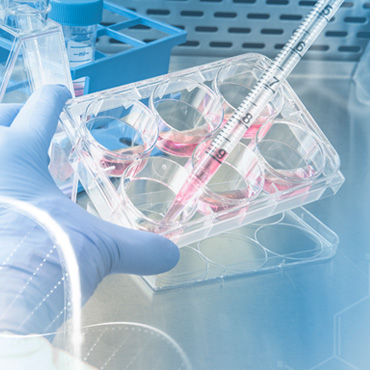Organ Failure
- Home
- Organ Failure
Our Treatments
Treating Organ & Tissue Failure
- With Stem Cells
Stem Cells Used in Organ/Tissue Failure
Here are some examples of stem cell types that have been investigated for treating organ failure:
- Mesenchymal Stem Cells (MSCs): MSCs are a type of adult stem cell that can differentiate into various cell types, including those found in connective tissues, such as bone, cartilage, and adipose tissue. MSCs have been studied for their regenerative and immunomodulatory properties and have shown potential in treating organ failure in the liver, kidney, heart, and lungs, among others.
- Hematopoietic Stem Cells (HSCs): HSCs are found in bone marrow and have the ability to differentiate into various blood cell types, including red blood cells, white blood cells, and platelets. HSCs have been used in the treatment of hematopoietic disorders, such as leukemia and lymphoma, where organ failure can occur due to the compromised production of blood cells.
- Induced Pluripotent Stem Cells (iPSCs): iPSCs are generated by reprogramming adult cells, such as skin cells, to a pluripotent state. iPSCs have the potential to differentiate into any cell type in the body, making them a versatile tool for regenerative medicine. iPSCs have been studied for their potential in treating organ failure, as they can be differentiated into specific cell types of the affected organs.
- Cardiac Stem Cells: Cardiac stem cells are a type of stem cell found in the heart that have the ability to differentiate into cardiac muscle cells. They have been investigated for their potential in treating heart failure and promoting cardiac regeneration.
- Liver Stem Cells: Liver stem cells, also known as hepatic progenitor cells, are a population of cells with regenerative potential in the liver. These cells have been studied for their ability to promote liver regeneration and improve liver function in cases of liver failure.
- Lung Stem Cells: Lung stem cells are being explored for their regenerative potential in treating lung diseases, such as chronic obstructive pulmonary disease (COPD) and idiopathic pulmonary fibrosis (IPF). These stem cells have the capacity to differentiate into various lung cell types and may contribute to lung tissue repair and regeneration.
Expected Efficacy Outcomes
It is important to note that the specific outcomes achieved with stem cell therapy for organ failure can vary between individuals and depend on several factors, including the patient's unique physiology, the stage and severity of the organ failure, the choice of stem cell type, and the treatment approach. Further research, clinical trials, and long-term follow-up studies are needed to establish the safety, efficacy, and optimal protocols for different organ types and specific patient populations.
- Tissue Regeneration and Repair: Stem cell therapy aims to promote tissue regeneration and repair in the failing organ. By introducing stem cells capable of differentiating into specific cell types, the therapy aims to replace damaged or dysfunctional cells, restore tissue architecture, and enhance organ function. The regeneration and repair of the affected organ can lead to improved overall organ performance.
- Functional Improvement: Stem cell therapy seeks to improve the functional abilities of the failing organ. This can include restoring normal cellular function, enhancing organ-specific activities, and improving the organ's capacity to carry out its physiological roles. The therapy aims to enhance organ function, which can lead to improvements in symptoms, reduced dependency on external interventions (e.g., medications, devices), and enhanced quality of life for the individual.
- Reduction of Symptoms: Treating organ failure with stem cells can result in the alleviation or reduction of symptoms associated with the failing organ. This can include improvements in pain, breathlessness, fatigue, or other symptoms that impact daily life. The reduction in symptoms contributes to an enhanced sense of well-being and improved functional capacity.
- Disease Progression Control: Stem cell therapy may help slow down or halt the progression of the underlying condition causing organ failure. By promoting tissue regeneration, reducing inflammation, or modulating the immune response, stem cells can contribute to disease modification and prevent further damage to the organ. This can lead to a stabilization of the condition and prevent or delay the need for more invasive interventions.
- Long-Term Sustainability: Stem cell therapies aim to provide sustainable and long-lasting effects. The goal is to achieve lasting improvements in organ function, tissue regeneration, and symptom relief. By establishing durable outcomes, stem cell therapy can potentially reduce the need for repeat treatments and provide long-term benefits for the individual.
Important Note:
While stem cell therapy for organ failure holds promise, it is essential to note that further research, preclinical studies, and clinical trials are needed to establish the optimal protocols and safety profiles for different organ types and specific patient populations. Close collaboration with healthcare professionals experienced in stem cell therapies is crucial to ensure the appropriate and informed application of these emerging treatment approaches.
It is important to note that these treatments are still considered experimental and have not yet received approval from Western medical standards. While there have been promising results and anecdotal evidence of positive outcomes, there is currently no definitive scientific proof of a cure for any specific condition using stem cell therapy.
It is crucial to understand that what works for one patient or in a small sample size may not necessarily be applicable to others or prove effective in larger clinical trials.
Patients considering stem cell therapy should be aware of the experimental nature of these treatments and exercise caution when evaluating potential benefits.



